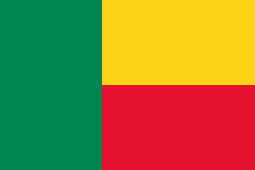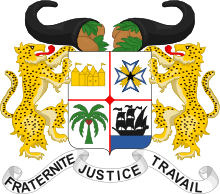History of Benin
- Note: This article is about the modern nation of Benin, which encompasses the former French colony of Dahomey, located west of Nigeria. It is easily confused with the historical empire governed by the Oba of Benin from the 14th century until 1897, from a seat of power sited at Benin City in present-day Nigeria.
| Part of a series on the |
| Culture of Benin |
|---|
 |
| History |
| People |
| Languages |
| Cuisine |
| Religion |
| Art |
| Literature |
|
Music and performing arts |
|
Monuments |
|
Symbols |
|
Part of a series on the |
|---|
| History of Benin |
 |
|
|
The Republic of Benin was formed in 1960 when the colony of French Dahomey gained independence from France. Prior to this, the area that is now the Republic of Benin was divided largely between two coastal kingdoms, Dahomey and Porto-Novo, and a large area of various tribes in the north. The French assembled these various groups together into the colony of French Dahomey, which was part of the various colonies of French West Africa from 1904 until 1960. In the independence era, the republic was extremely unstable for the first decade and a half of existence, with multiple governments and multiple military coups. In 1972, Mathieu Kérékou led a military coup deposing the Presidential Council and appointing himself as the head of state, a position he held until 1991 when the country returned to multiparty elections. Since that point, the state has held multiple presidential and legislative elections and a number of different parties have become important.
Colonial Benin (formerly, République du Dahomey/Republic of Dahomey)
Dahomey was a French colony of and a part of French West Africa from 1904 to 1958. Under the French, a port was constructed at Cotonou, and railroads were built. School facilities were expanded by Roman Catholic missions. In 1946, Dahomey became an overseas territory with its own parliament and representation in the French national assembly. On December 4, 1958, it became the République du Dahomey, self-governing within the French Community. On 11 July 1960 France agreed to Dahomey becoming fully independent.[1] Dahomey declared independence on 1 August 1960.
Post-colonial Benin
Between 1960 and 1972, a succession of military coups brought about many changes of government.[2] The last of these brought to power Major Mathieu Kérékou as the head of a regime professing strict Marxist-Leninist principles.[3] By 1975 the Republic of Dahomey changed its name to the People's Republic of Benin.[4] The People's Revolutionary Party of Benin (PRPB) remained in complete power until the beginning of the 1990s. Kérékou, encouraged by France and other democratic powers, convened a national conference that introduced a new democratic constitution and held presidential and legislative elections. Kérékou's principal opponent at the presidential poll, and the ultimate victor, was Prime Minister Nicéphore Soglo. Supporters of Soglo also secured a majority in the National Assembly.[5] Benin was thus the first African country to effect successfully the transition from dictatorship to a pluralistic political system.[6]
In the second round of National Assembly elections held in March 1995, Soglo's political vehicle, the Parti de la Renaissance du Benin, was the largest single party but lacked an overall majority. The success of a party formed by supporters of ex-president Kérékou, who had officially retired from active politics, allowed him to stand successfully at both the 1996 and 2001 presidential elections.[5]
During the 2001 elections, however, alleged irregularities and dubious practices led to a boycott of the run-off poll by the main opposition candidates. The four top-ranking contenders following the first round presidential elections were Mathieu Kérékou (incumbent) 45.4%, Nicephore Soglo (former president) 27.1%, Adrien Houngbédji (National Assembly Speaker) 12.6%, and Bruno Amoussou (Minister of State) 8.6%. The second round balloting, originally scheduled for March 18, 2001, was postponed for days because both Soglo and Houngbedji withdrew, alleging electoral fraud. This left Kérékou to run against his own Minister of State, Amoussou, in what was termed a "friendly match."[5]
In December 2002, Benin held its first municipal elections since before the institution of Marxism-Leninism. The process was smooth with the significant exception of the 12th district council for Cotonou, the contest that would ultimately determine who would be selected for the mayoralty of the capital city. That vote was marred by irregularities, and the electoral commission was forced to repeat that single election. Nicephore Soglo's Renaissance du Benin (RB) party won the new vote, paving the way for the former president to be elected Mayor of Cotonou by the new city council in February 2002.[5]
National Assembly elections took place in March 2003 and were generally considered to be free and fair. Although there were some irregularities, these were not significant and did not greatly disrupt the proceedings or the results. These elections resulted in a loss of seats by RB—the primary opposition party. The other opposition parties, the Party for Democratic Renewal (PRD) led by the former Prime Minister Adrien Houngbedji and the Alliance Etoile (AE), joined the government coalition.[5]
Former West African Development Bank Director Yayi Boni won the March 2006 election for the presidency in a field of 26 candidates. International observers including the United Nations, Economic Community of West African States (ECOWAS), and others called the election free, fair, and transparent. President Kérékou was barred from running under the 1990 constitution due to term and age limitations. President Yayi was inaugurated on April 6, 2006.[5]
Benin held legislative elections on March 31, 2007, for the 83 seats in the National Assembly. The Force Cowrie for an Emerging Benin (FCBE), a coalition of parties, closely linked to President Yayi, won a plurality of the seats in the National Assembly, providing the president with considerable influence over the legislative agenda.[5]
See also
- History of Africa
- History of West Africa
- List of heads of government of Benin
- List of heads of state of Benin
- Politics of Benin
- Timeline of Cotonou
Notes
- ↑ http://select.nytimes.com/mem/archive/pdf?res=F70F1FFD385A1A7A93C0A8178CD85F448685F9
- ↑ Decalo, Samuel (1997). "Benin: First of the new democracies". In John F. Clark & David E. Gardinier. Political Reform in Francophone Africa. Boulder, CO: Westview Press. pp. 43–61.
- ↑ Profiles of People in Power: The World's Government Leaders (2003), page 55.
- ↑ Jamie Stokes. Encyclopedia of the Peoples of Africa and the Middle East: L to Z. Infobase Publishing, 2009. ISBN 0-8160-7158-6, p110.
- 1 2 3 4 5 6 7 "Background Note: Benin". U.S. Department of State (June 2008).
 This article incorporates text from this source, which is in the public domain.
This article incorporates text from this source, which is in the public domain. - ↑ Thomson Gale (Firm). Countries of the world and their leaders yearbook 2007, Volume 1. Thomson Gale, 2006. ISBN 0-7876-8104-0, p212
References
 This article incorporates public domain material from the CIA World Factbook website https://www.cia.gov/library/publications/the-world-factbook/index.html.
This article incorporates public domain material from the CIA World Factbook website https://www.cia.gov/library/publications/the-world-factbook/index.html. This article incorporates public domain material from the United States Department of State website http://www.state.gov/r/pa/ei/bgn/index.htm (Background Notes).
This article incorporates public domain material from the United States Department of State website http://www.state.gov/r/pa/ei/bgn/index.htm (Background Notes).
External links
- Rulers.org — Benin – List of rulers for Benin